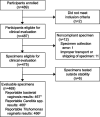Performance of a Vaginal Panel Assay Compared With the Clinical Diagnosis of Vaginitis
- PMID: 34736269
- PMCID: PMC8594526
- DOI: 10.1097/AOG.0000000000004592
Performance of a Vaginal Panel Assay Compared With the Clinical Diagnosis of Vaginitis
Abstract
Objective: To compare the performance of vaginitis diagnosis based on clinical assessment to molecular detection of organisms associated with bacterial vaginosis, vulvovaginal candidiasis, and Trichomonas vaginalis using a vaginal panel assay.
Methods: This cross-sectional diagnostic accuracy study included 489 enrolled participants from five collection sites where those with vaginitis symptoms had a vaginal assay swab collected during their visit and a clinical diagnosis made. The swab was later sent to a separate testing site to perform the vaginal panel assay. Outcome measures include positive, negative, and overall percent agreement (and accompanying 95% CIs) of clinical assessment with the vaginal panel assay. P<.05 was used to distinguish significant differences in paired proportions between the vaginal panel assay and clinical diagnosis, using the McNemar test. Inter-rater agreement between the two diagnostic approaches was determined using Cohen's kappa coefficient.
Results: Clinical diagnosis had a positive percent agreement with the vaginal panel assay of 57.9% (95% CI 51.5-64.2%), 53.5% (95% CI 44.5-62.4%), and 28.0% (95% CI 12.1-49.4%) for bacterial vaginosis, vulvovaginal candidiasis, and T vaginalis, respectively. Negative percent agreement for clinical diagnosis was 80.2% (95% CI 74.3-85.2%), 77.0% (95% CI 72.1-81.4%), and 99.8% (95% CI 98.7-99.9%), respectively. Sixty-five percent (67/103), 44% (26/59), and 56% (10/18) of patients identified as having bacterial vaginosis, vulvovaginal candidiasis, and T vaginalis by assay, respectively, were not treated for vaginitis based on a negative clinical diagnosis. Compared with the assay, clinical diagnosis had false-positive rates of 19.8%, 23.0%, and 0.2% for bacterial vaginosis, vulvovaginal candidiasis, and T vaginalis, respectively. Significant differences in paired proportions were observed between the vaginal panel assay and clinical diagnosis for detection of bacterial vaginosis and T vaginalis.
Conclusion: The vaginal panel assay could improve the diagnostic accuracy for vaginitis and facilitate appropriate and timely treatment.
Funding source: Becton, Dickinson and Company.
Copyright © 2021 by The Author(s). Published by Wolters Kluwer Health, Inc.
Conflict of interest statement
Financial Disclosure Molly Broache, Elizabeth Stonebraker, and Karen Eckert are employees of the study sponsor, Becton, Dickinson and Company, BD Life Sciences – Integrated Diagnostic Solutions, and hold stock with Becton, Dickinson and Company. Stephanie N. Taylor reports receiving grants to her institution, honorarium, and consulting fees from Abbott Molecular, Becton Dickinson, binx health, Cepheid, Hologic, Cepheid, binx, Rheonix, Roche, and Abbott Molecular. Barbara Van Der Pol reports receiving grants to her institution, honorarium, and consulting fees from Abbott Molecular, BD Diagnostics, Becton Dickinson, binx health, BioFire, Cepheid, Hologic, Rheonix, Roche and SpeeDx. Catherine L. Cammarata did not report any potential conflicts of interest.
Figures


